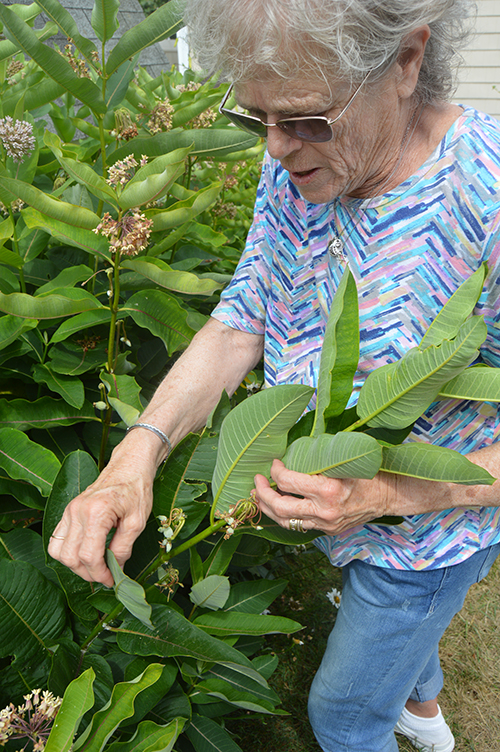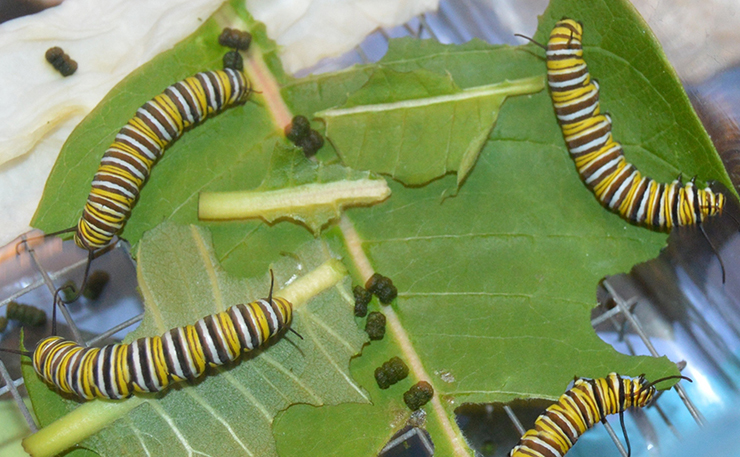If you can grow milkweed, you can create a monarch butterfly habitat.
These garden retreats are beautiful and help protect a threatened species
By Marjorie Preston
“If we are ever to love a butterfly, we must first care for a few caterpillars.”
That quote, from French writer Antoine de Saint-Exupéry, has special meaning for Jan Sarratore.
As a kindergarten teacher in Indiana, Sarratore taught her students to raise butterfly eggs from caterpillar to chrysalis. She didn’t tell them they were growing monarchs, the most recognizable of butterflies, with their vivid orange and black wings.
At last, when the winged creatures broke free of their shells, “The kids would just go, ‘Whoa,’” said Sarratore. “It’s a miracle, and wondrous to show to children.”
Today, as a member of the Brigantine Garden Club, the South Jersey transplant continues to teach, showing others how to create monarch waystations. These pollinator gardens help the butterflies survive—and they need all the help they can get.
Loss of habitat, climate change, and the scarcity of milkweed, their sole host plant and food source, has imperiled the butterflies, whose annual migration to Mexico is one of the natural wonders of the world.
In 2020, the U.S. Fish and Wildlife Service acknowledged that monarchs are endangered, but declined to place them on the endangered species list due to “higher priority listing actions.” The International Union for Conservation of Nature does list the species as endangered, saying it’s at high risk for extinction in the wild.
Luckily, people can help.

Jan Sarratore looks for monarch eggs.
How Does Your Garden Grow?
First, a waystation needs at least six milkweed plants in soil that gets at least six hours of sun per day. Adult monarchs lay their eggs on the leaves of the plants. After the eggs hatch, the caterpillars live on the sticky, bittersweet milk inside the leaves until they spin themselves into cocoons (the milk contains a toxin that makes the creatures inedible to predators).
A waystation also needs trees or shrubs for shelter, a water source (shallow, so the winged insects won’t drown), and a variety of flowering plants that will bloom from early spring to fall. The flowers’ nectar supplements the diet of the adult monarch.
For instance, Sarratore’s garden includes irises, daffodils and spiderwort in the spring; day lilies, black-eyed Susans, butterfly weeds and sedum in the summer; and goldenrod, zinnias and chrysanthemums in the fall. The butterflies love them, and in migrating season, flock to her yard by the hundreds.
Kim Glomb, also of Brigantine, began raising monarchs after attending one of Sarratore’s demonstrations. Her summer garden includes tiger lilies and obedient plants, a perennial that resembles snapdragons. They attract not just monarchs but bees, other small insects and hummingbirds.
Using starter milkweed plants is easier than growing from seed, says Glomb. But the plants are “pretty carefree, once you get them established.”
Milkweeds are an invasive species, so prune accordingly, pull up and give away any new sprouts, and in the fall, when the pods split open, let the seeds disperse, to create new plants. Of course, avoid using pesticides.
While it’s possible to grow milkweed in pots, the tap roots grow from eight or ten feet, and even a big pot can’t sustain that kind of growth for more than a season or two.

Caterpillars in the nursery, feeding on milkweed leaves
The Circle of Life
Having a monarch waystation in the yard is a great way to observe its life cycle from pinpoint-sized egg to adult. And it’s quite the drama. In mating season, a dominant male will circle the habitat, guarding his territory, before finally attaching to a female. Then, like Tarzan, he’ll fly her up a tree for mating.
Once impregnated, the female lays up to 400 eggs on the undersides of milkweed leaves; about one in 10 will survive to adulthood. Hand-raising in an indoor butterfly nursery helps them along.
Simply place the leaves and attached eggs inside a small mesh container. Tiny caterpillars soon will emerge and feed on the leaves, continuing to grow and molt until they’re about three inches long (the caterpillars themselves are beautiful, with yellow, green, and black stripes).
Then it’s time to weave their cocoons, or pupae, which hang vertically inside their nursery or other container (Sarratore maintains a separate, outdoor enclosure for the chrysalis stage).
The butterflies form inside these cocoons, which are pale green with gold dots, and resemble jade pendants. In eight to 14 days comes the ”Whoa!” moment as they emerge, dry out their wings, and are ready to fly.
Given the right environment, monarch butterflies will reappear every spring and reproduce every summer. Their average life span is about six weeks, with the exception of a “super-generation,” which is hearty enough to make the amazing trek south to Mexico. These migrators, which weigh less than a snowflake, fly up to 3,000 miles, then overwinter in the Mexican forest before beginning the flight back in the spring.
“Every monarch from the eastern seaboard east of the Rockies goes to Mexico, to the middle of nowhere,” marvels Steve Sarratore, Jan’s husband, a former college professor. “It’s the largest migration of any butterfly known.”

Adult monarch
But the numbers are dwindling. According to the Environmental Defense Fund (EDF), more than 90 percent of North American monarchs have been wiped out in the last 20 years. To help the species endure, and increase the health of the ecosystem, consider a monarch waystation.
“It’s just the wonder of nature,” said Jan Sarratore. “When the milkweed appears, the butterflies aren’t far behind.”
For more information, visit EDF.org or Monarchwatch.org.
Marjorie Preston is a business writer, editor, ghostwriter and compulsive reader, who gobbles up books like potato chips. For more information (and more book reviews), visit marjorieprestonwriting.com.












